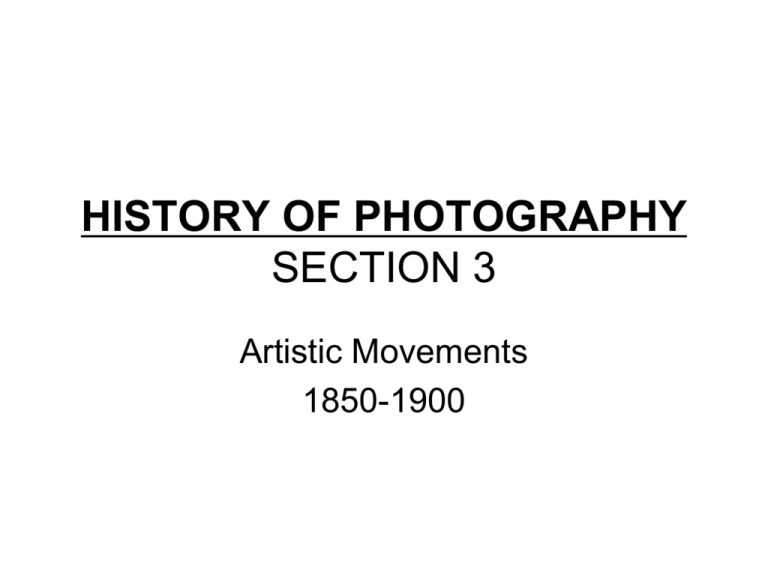File
advertisement

HISTORY OF PHOTOGRAPHY SECTION 3 Artistic Movements 1850-1900 ART (artistic) PHOTOGRAPHY • Some artists believed photography corrupted the artistic process – Images were considered “too real” – No room for imagination • Major effort to legitimize photo as Art • The ‘new’ idea was that PHOTOGRAPHY can IMITATE ART • Themes - very melodramatic, dreamlike • Reflected other Victorian era art forms ARTISTIC TECHNIQUES • Very staged and planned compositions • Combined negatives to achieve desired results (ie. sort of an early version of photoshop layers) • Manipulated the printing in dark room • Used models, sets, and dramatic lighting to set an artistic mood • These early ‘artistic’ photographs are identified as art -- as relevant as painting Oscar Gustave Rejlander (1813-1875) • Considered the “father of Art photography” • Inspired a movement of artists to follow his artistic vision for photo • --“we can make photography the next great art form” • Criticized by other photographers for using manipulation • Started with portraits later created more detailed and elaborate compositions Boy and Girl in Colonial Costume -1860, albumen print Oscar Rejlander Portrait of Two Girls --1860 Putto as Allegory for Painting --1886 Oscar Rejlander The Bachelors Dream—1860, Albumen Print Oscar Rejlander Hard Times --1860 – Spiritistic Photograph – Combination Albumen Print (two negatives) Oscar Rejlander • The Two Ways of Life -- 1858 -- Gelatin Silver Print – – – Theme- Virtue vs. Vice 30 separate negatives used Elaborate staging and costumed models used for photo Oscar Rejlander • Becomes tired of making artistic photos • Writes letter to Henry Peach Robinson: --“I am tired of photography for the public, particularly composite photos, for there can be no gain and there is no honor but cavil* and misrepresentation…” * (‘cavil’ means petty or unnecessary objections) Henry Peach Robinson (18301901) • English pictorialist photographer • Best known for his pioneering combination printing • In 1856, with Rejlander, founded the Birmingham Photographic Society • Forced to give up his studio at age 34 due to illhealth from exposure to toxic photographic chemicals • Continued to work with theoretical practices in writing and advocacy Henry Peach Robinson (contd.) • 1869 published a book entitled Pictorial Effect in Photography: Being Hints On Composition And Chiaroscuro For Photographers • In this he maintains that the composite image is directly affected by his hand, and therefore Art • One of the primary forces behind the rise of pictorialism was the belief that straight photography was purely representational ‒ that it showed reality without the filter of artistic interpretation – therefore simply a record of facts, lacking artistic intent or merit Fading Away – 1858 - composite image from five different negatives When the Day’s Work is Done – 1877, composite image from six different negatives Julia Margaret Cameron (18151879) • Came to photography at age 48 when daughter gave her a camera • Within a year, became a member of the Photographic Societies of London and Scotland • Known for soft focus “fancy” portraits taught to her by David Wilkie Wynfield who had developed a technique of shallowfocus portrait photography Julia Margaret Cameron (contd.) • The bulk of Cameron's photographs fit into two categories—closely framed portraits and illustrative allegories based on religious and literary works. • The allegorical work most closely resembles the work of the Pre-Raphaelites, with far away looks, limp poses and soft lighting • Significance of her work attributed to making the only photos of famous figures (especially literary) Pre-Raphealite work Proserpine by Dante Gabriel Rosetti 1874, Oil on canvas Peter Emerson (1856-1936) • His photos are early examples of promoting photography as an art form • Most work displays a natural setting • Believed the photograph should be a true representation of what the eye saw • Claimed that photography should be seen as a genre of its own, not one that seeks to imitate other art forms. Field Workers at Rest 1885, platinum print Impressionist Paintings (artistic style of the time period 1860’s-90’s) Luncheon of the Boating Party -1881 – Pierre-Auguste Renoir Sunday Afternoon on the Isle of La Grande Jatte (1884-86) -Georges Seurat Characteristics of Impressionism • • • • Visible brush strokes Open composition Ordinary subject matter Emphasis on depiction of light in its changing qualities (accentuating passage of time) • Inclusion of movement as a crucial element of human perception • Unusual visual angles Peter Emerson Gathering Water Lilies-1886, Platinum Print Peter Emerson In the Barley Harvest -1890 Broxbury Church -1888 Peter Emerson Furze Cutting -1885 Platinum Print The Haunt of the Pike -1885 Peter Emerson A Winter’s Sunrise --1890 Pictorialism further defined: • Lack of sharp focus • Printed in one or more colors (browns to deep blues) • Not composites, not exaggerated or melodramatic • Possible manipulation of surface • Projecting emotional intent upon the viewer’s imagination (in common with the ‘artistic style) Alfred Steiglitz (1864-1946) • Father of Modern Photography • Started out as pictorialist, but thought manipulation wasn’t necessary • Opened Little Galleries of the Photo-Secession (more well known as ‘291’- an art gallery in NYC located on 291 Fifth Avenue) – Promoted art, and photography (often together) – Emphasis on design concepts such as composition, shape, form, etc. – Published Camera Work to promote the new art of photography. Established new modern aesthetic (Modernist’) Sunlight and Shadows - 1889 Alfred Steiglitz – The Terminal, 1893 Alfred Steiglitz Spring Showers NY- 1901 Flat Iron Building NY- 1903 Alfred Steiglitz Venetian Boy-1887 Alfred Steiglitz The Steerage -1907 Other Pictorialist Work Emile Puyo - The Gorgons Head -1898 George Seeley - The Firefly -1907 More Pictorialist Work Edward Steichen - Self-Portrait 1901 Clarence White- Morning -- 1908 Portrait of J.P. Morgan 1903 By Edward Steichen The Flatiron 1904 By Edward Steichen








